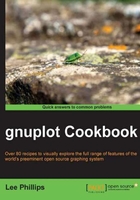
Why gnuplot?
gnuplot is a free, open source plotting program that has been in wide use since 1986. It's used as the graphics backend by many other programs, so plenty of people use gnuplot without knowing it. If you've used Octave, Maxima, statist, gretl, or the Emacs graphing calculator, you've already used gnuplot.
gnuplot was originally designed to visualize scientific data, but its use has expanded to encompass every domain where sophisticated and accurate plotting is required. gnuplot is used in science, engineering, sociology, mapping, business, finance, and computer systems and network monitoring.
gnuplot excels at complex 3D graphing with hidden-line removal and at the rendering of surfaces and contours. It can produce almost any type of graph imaginable (except for pie-charts—but it can be convinced to do this, too, as we'll show later!) for a dizzying array of output devices, and can save plots in almost any type of common file format (and some uncommon ones). It can be installed on any type of computer system you are likely to encounter; there are binaries available for Windows and the sources can be compiled on most reasonably modern machines. I have compiled the latest version (4.4) of gnuplot on both Linux and Macintosh (OS X) computers and verified that all of its advanced features are fully available on both of these architectures. The recipes in this book that illustrate features newly appearing in version 4.4 are marked with [new].
gnuplot can easily be automated. It has its own scripting language and can be controlled from many general-purpose programming languages. gnuplot can also be incorporated into various publishing and document creation workflows to help create professional books, papers, and online documents.